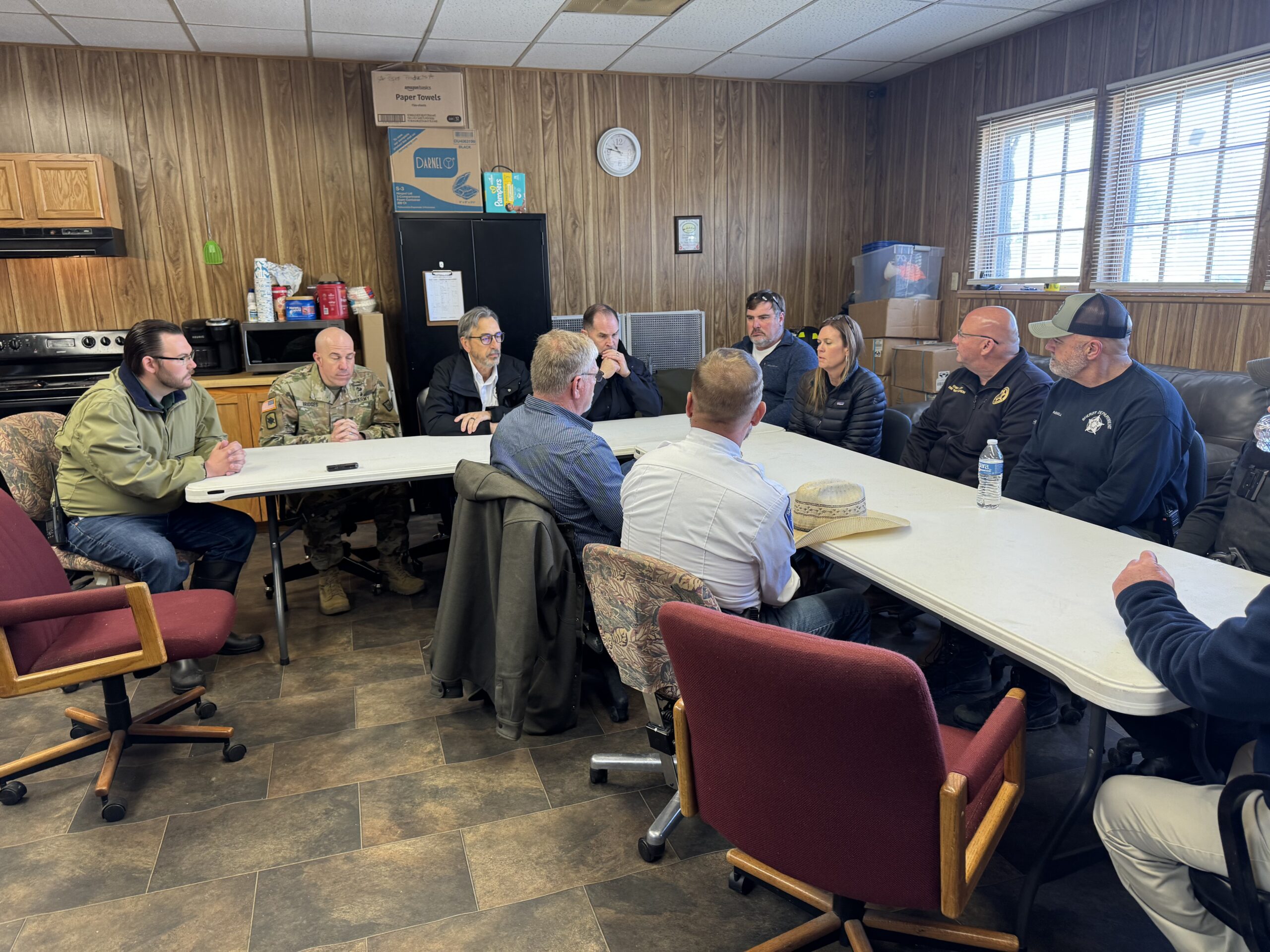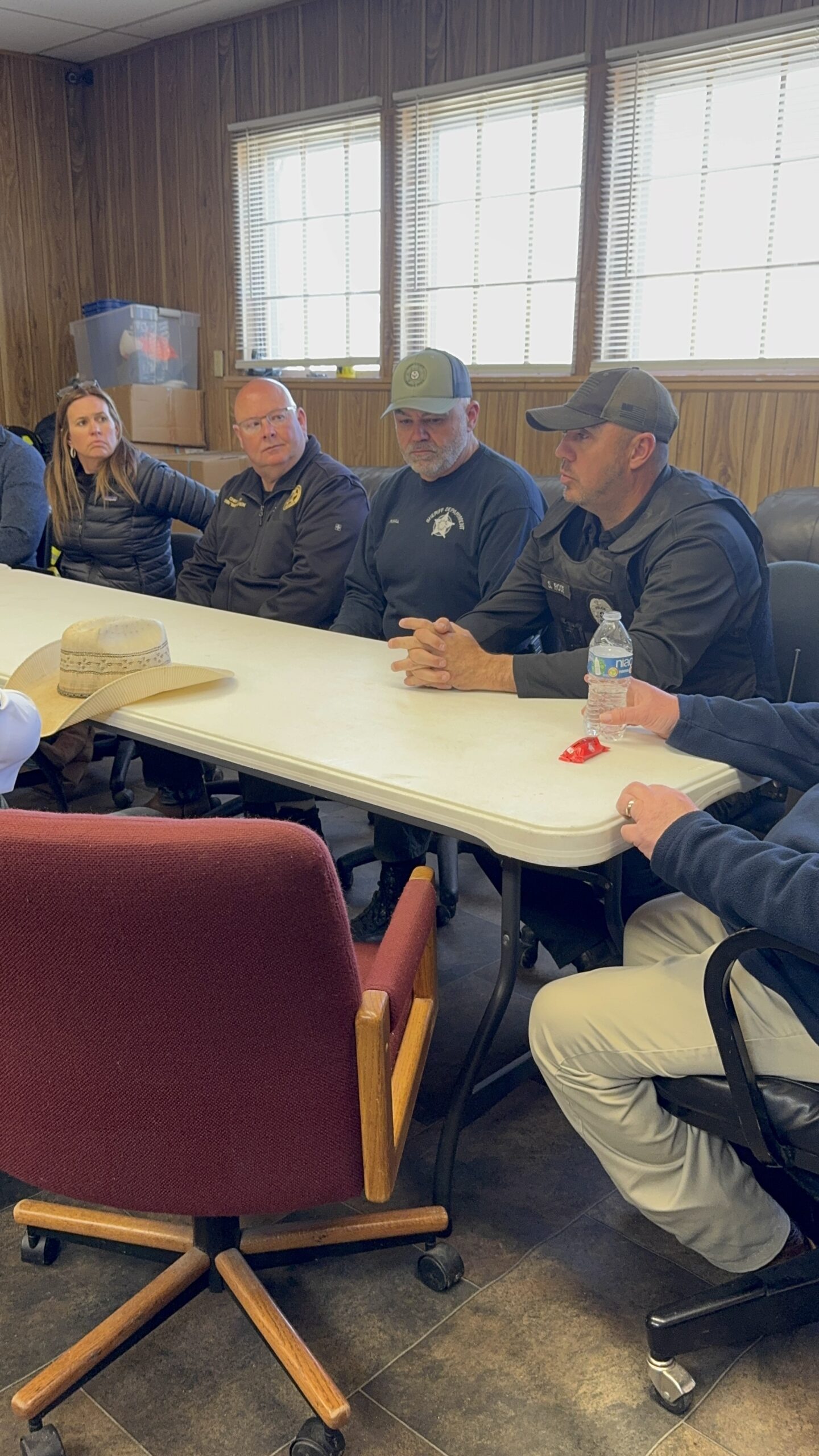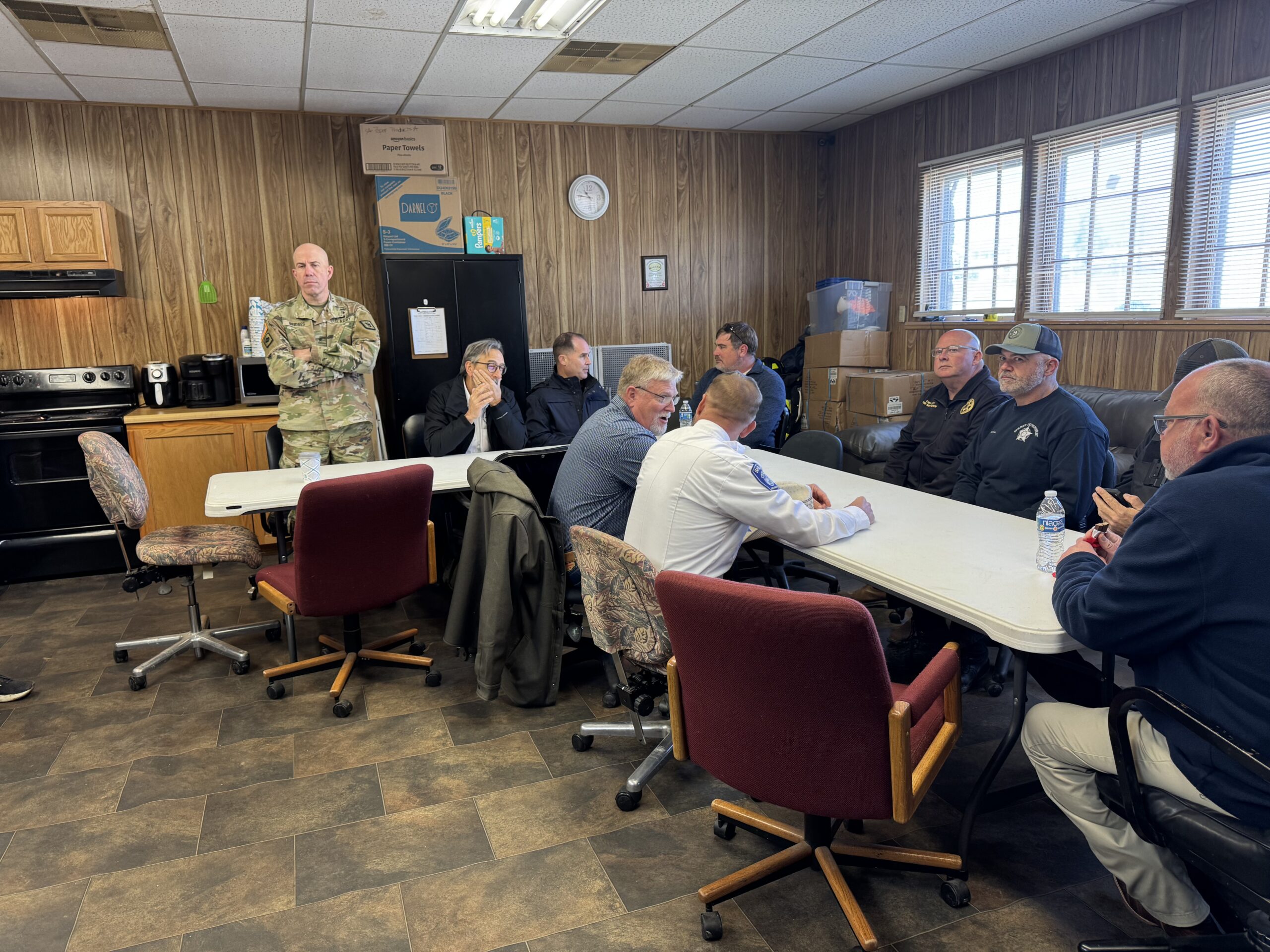Governor Sarah Huckabee Sanders took time to tour Hardy April 7 and spend some time hearing from local officials.
During a briefing, prior to the press conference, Sanders heard concerns from Hardy Mayor Ethan Barnes, Hardy Police Chief Scott Rose, Fulton County Judge Ken Crow, Fulton County Sheriff Jake Smith, Sharp County Sheriff Mark Counts and Sharp County Sheriff Shane Russell and others present.
During the briefing, local officials shared the challenges faced including the need for temporary housing, funding for road repair, direction on getting the waterways cleared from debris and more.
The briefing was opened by Barnes who stated preparation for the disaster began days before floodwaters arrived.
“We went into operation here early this week. Chief Rose received a call from the National Weather Service and he asked Chief if he was sitting down and that is never a good question to ask a police chief. He immediately contacted me and told me it was going to be a devastating event, and at that time they were calling for 19 feet. We got up to 22.82, but I don’t believe it. I really think it was higher than that because USGS came to recover their device and I found them at the bridge, but they couldn’t get to it (because of the water),” Barnes said.
Although mandatory evacuations could not be forced, Barnes said red notices were taken to every home and structure identified as being in the flood zone.
The letter urged all recipients to evacuate and utilize the American Red Cross Shelter set up at the Hardy Gym.
“We tried to get to every person we could to get these out there. At that time, we contacted the county judge, we had four loads of sand brought up here and filled over 2,000 sandbags and got them to as many people as we could.. but that didn’t help at all. We tried but we couldn’t keep the waters down,” Barnes said.
By Friday evening, Barnes said teams were dispatched to aid in evacuations, some of which were life threatening.
Rose said he attributed the lack of evacuations to delayed rainfall.
“A lot of false sense of security started happening because we didn’t see the rain they thought we were going to get but when we saw what was happening in West Plains and Southern Missouri I began to get concerned. At first, I started to doubt it because we weren’t seeing the rain, but then I started getting updates from the National Weather Service and their numbers just kept rising,” Rose said. “The last forecast was 24 feet.”
In the early morning hours of Saturday April 6, Barnes said a strong breeze could be felt and Sheriff Russell noted water levels began rising by as much as a foot per half an hour to as frequently as every 15 minutes.
Rose added to the urgency by comparing floods, “We hadn’t gotten much rain here yet, but we started watching our roads going under,” Rose said. “I grew up here, and this flood was different than in 2008, even though the numbers were similar, but I received a phone call around 10 p.m. from the Mammoth Spring Police Chief that the river was level with the dam.”
Russell said the rain from both the north and south played a key role in the severity of the flooding.
Barnes said that the command station set up at the Hardy Fire Department, the sheriff’s department, a hub for dispatch, ADEM (Arkansas Department of Emergency Management) and others were all present.
Fulton County Judge Ken Crow said Hardy got the brunt of the devastation but Fulton County saw waters in places not seen before.
“A lot of people in my county compared it to the flood of 1982. The water got into the electric co-op. We had several calls from people not being able to get out and isolated,” Crow said.
He mentioned touring in a helicopter and that the scope of disaster is made much more clear from that vantage point, than simply driving by.
“You get a different perspective from the air then when you’re driving on the road. We have some river crossings that are completely gone. Some culverts are completely impassible. We put over $50,000 (in materials) on the roads in the last few months but no amount of engineering can withstand what we went through. We had 13 bad bridges before, now we have 30,” Crow said. “ARDOT (Arkansas Department of Transportation) called and had us close one yesterday. The Spring River Cold Springs Access is a number one priority for replacement but now there is an urgency to get those done. We’ve got 685 dirt and 50 miles of pavement so it’s really a challenge. Our focus is on getting the roads passable right now.”
Crow listed other areas that sustained major damage and said it was a similar story for the surrounding counties.
“I talked to Izard County Judge Eric Smith and his county is smashed. Our whole county is smashed. Now it’s just trying to put it back together again,” Crow said.
Governor Sanders asked aside from roads which she recognized as a priority, what the other biggest needs were.
Crow said structural damage, leaking roofs and other issues being faced needed to be addressed.
Sheriff Jake Smith stated there were five homes that had to be evacuated, but because the waterways in Fulton County act more like tributaries rather than rivers, they did see destruction, but not to the level of the communities along the rivers and down stream.
“It came up high, but a lot of the population was pretty prepared. Our people took good precautions,” Smith said.
Crow said a lack of a hazard mitigation plan also contributed to the problems in Fulton.
Judge Counts said presently from a county wide perspective, roadways and bridges were the biggest obstacle.
“We have several bridges and ARDOT is helping with that and looking at the structural stability, but that will be our biggest headache, trying to get the roads back up and passable,” Counts said.
Barnes said some of the needs in and around Hardy include the city’s parks.
“Loberg and Buford beach along the river which is a game and fish access point. Several of our streets have been lifted away,” Barnes said. “One need I know, and I’m just going to be transparent, there is a lot of cleanups out here. We don’t have the manpower, money and don’t know where to start.”
Both Barnes and Rose mentioned the influx of debris from above Hardy coming down from other communities along the river.
“It’s not safe for us to send volunteers out there or to just start trying to pick things up. I don’t want anyone to be hurt. We could use some machinery. Another issue is I can’t touch the river, but we’ve got debris all up and down the river and that is dangerous for anyone on boats, fisherman, people trying to swim or float the river when it calms back down, it’s just not safe right now. There are vehicles, campers, buildings and other things in that water right now,” Barnes said.
Barnes also noted tourism season is less than six weeks away and it is vital for the survival of local businesses as they depend on income from the spring and summer months to carry through the winter.
Governor Sanders mentioned those were areas in which the state could help.
“We can aid in that and also when you do have volunteers and people who want to engage the way they separate debris is really important and helpful to getting things done quicker,” Sanders said before turning the floor over to Department of Public Safety Director AJ Gary.
“First of all, we break it up into a couple areas, response to make sure everyone is okay and you’ve done a fantastic job with that. Two of my team members have been up here and will stay here and continue to work with y’all. We’re going into the recovery phase, one of the benefits of coming up and doing the flyover and to hear the stories and impact, we have another team in FEMA that are flying over the state and assessing damage. There is information we have to gather and once we get that we can make determinations on the federal declaration, and we have some state programs. By chance there is not enough damage for a federal declaration, which I think we do, there are state programs,” Gary said.
Prioritizing the order of operations for best outcomes, Gary said getting the city and county together to create a debris staging area was key, but so was how materials are separated.
“One of the immediate things we need to do and I would suggest you do it county and city together. Get a debris staging area. That is a key part, you need it separated. Construction debris from vegetation debris. Another thing, documentation. Keep up with all of your expenses, the amount of debris you take off the property, have citizens push it to the right of way but keep it separated,” Gary said. “I also have additional recovery staff. Recovery is not something that happens overnight, but we are with you though the whole thing. This will go on for months and possibly a couple of years…”
He also noted keeping up with volunteer organizations and the hours they spend in the area is vital.
“If you have volunteer organizations in here working get them to track their hours. Whatever program we get there is always cost share and things like that offset that cost share and it will save the taxpayers, city and county money.
Sanders said she would be in contact with the Game and Fish Commission later in the day regarding river cleanup.
“We can work with Game and Fish to see. They can help a lot of times with cleanup specifically in the river area and there are some specific projects they can help with,” Sanders said.” “We’ll work to move that quickly given tourism season is around the corner. We will work with them today to see what additional resources there are.”
Gary’s team noted permits had already been secured from the Arkansas Department of Environmental Quality to help speed up recovery efforts.
“The city of Hardy asks at this time to be patient, but to begin separating debris per ADEM guidelines shared to the city’s Facebook page. Contact ADEM with any questions regarding separating your debris. The cleanup phase begins now,” Barnes said.
For more information, river levels, guidelines and information you can also see a previous article: https://hallmarktimes.com/recovery-and-cleanup-efforts-underway-following-historic-flooding/.
Lauren is a an award-winning journalist who decided after 10 years of newspaper experience to venture out. Hallmark Times was born.









